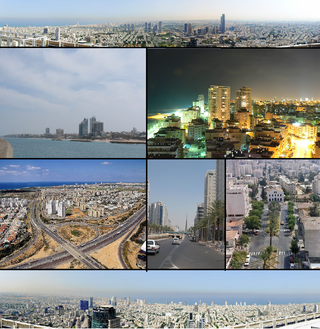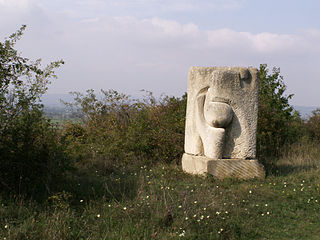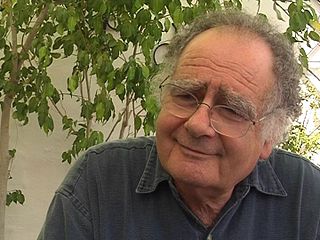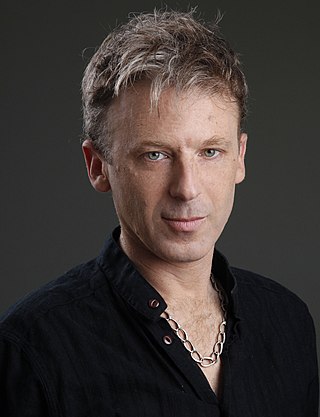
Tel Aviv-Yafo, sometimes rendered as Tel Aviv-Jaffa, and usually referred to as just Tel Aviv, is the most populous city in the Gush Dan metropolitan area of Israel. Located on the Israeli Mediterranean coastline and with a population of 474,530, it is the economic and technological center of the country and a global high tech hub. If East Jerusalem is considered part of Israel, Tel Aviv is the country's second-most-populous city, after Jerusalem; if not, Tel Aviv is the most populous city, ahead of West Jerusalem.

Daniel Libeskind is a Polish–American architect, artist, professor and set designer. Libeskind founded Studio Daniel Libeskind in 1989 with his wife, Nina, and is its principal design architect.

Gush Dan or Tel Aviv metropolitan area is a conurbation in Israel, located along the country's Mediterranean coastline. There is no single formal definition of Gush Dan, though the term is in frequent use by both governmental bodies and the general public. It ranges from combining Tel Aviv with cities that form an urban continuum with it, to the entire areas from both the Tel Aviv District and the Central District, or sometimes the whole Metropolitan Area of Tel Aviv, which includes a small part of the Southern District as well. Gush Dan is the largest conurbation and metropolitan area in Israel and the center of Israel's financial and High technology sector. The metropolitan area having an estimated population of 4,156,900 residents, 89% of whom are Israeli Jews.

Bat Yam is a city located on Israel's Mediterranean Sea coast, on the Central Coastal Plain just south of Tel Aviv. It is part of the Gush Dan metropolitan area and the Tel Aviv District. In 2020, it had a population of 160,000.

The Palmach Museum is a museum located in Ramat Aviv, Israel dedicated to the Palmach, the strike-force of the pre-state underground Haganah defense organization, which was later integrated into the Israel Defense Forces.

Daniel "Dani" Karavan was an Israeli sculptor best known for site specific memorials and monuments which merge into the environment.

The White City is a collection of over 4,000 buildings in Tel Aviv from the 1930s built in a unique form of the International Style, commonly known as Bauhaus, by German Jewish architects who fled to the British Mandate of Palestine from Germany after the rise to power of the Nazis. Tel Aviv has the largest number of buildings in the Bauhaus/International Style of any city in the world. Preservation, documentation, and exhibitions have brought attention to Tel Aviv's collection of 1930s architecture. In 2003, the United Nations Educational, Scientific and Cultural Organization (UNESCO) proclaimed Tel Aviv's White City a World Cultural Heritage site, as "an outstanding example of new town planning and architecture in the early 20th century." The citation recognized the unique adaptation of modern international architectural trends to the cultural, climatic, and local traditions of the city. Bauhaus Center Tel Aviv organizes regular architectural tours of the city.

The Cremer & Wolffenstein architecture firm was founded in Germany in 1882 by Richard Wolffenstein (1846–1919) and Wilhelm Cremer (1845–1919) and existed up to the death of its two founders. During the so-called Gründerzeit in Berlin, the years of rapid industrial expansion in Germany at the end of the 19th century, they were a prolific firm in the various aspects of architecture. As one of the largest firms in Berlin at the turn of the century, they designed residential, commercial, transportation, government, and religious buildings. They built a number of synagogues, won second place in the 1882 competition to design the Reichstag, and were also involved in planning the Hochbahn overhead railway installation between Kreuzberg and Nollendorfplatz.

Matanya Abramson was an Israeli sculptor whose sculptures have been exhibited worldwide as well as in Israel. Matanya was a versatile artist who worked in marble, stone, and wood, as well as with bronze, aluminum and copper castings.
The architecture of Israel has been influenced by the different architectural styles of those who have inhabited the country over time, sometimes modified to suit the local climate and landscape. Byzantine churches, Crusader castles, Islamic madrasas, Templer houses, Arab arches and minarets, Russian Orthodox onion domes, International Style modernist buildings, sculptural concrete Brutalist architecture, and glass-sided skyscrapers all are part of the architecture of Israel.

Avraham Yasky was an Israeli architect.

Emanuel Hatzofe was an Israeli sculptor.
Ram Karmi was an Israeli architect. He was head of the Tel Aviv-based Ram Karmi Architects company, and is known for his Brutalist style.

Arieh Sharon was an Israeli architect and winner of the Israel Prize for Architecture in 1962. Sharon was a critical contributor to the early architecture in Israel and the leader of the first master plan of the young state, reporting to then Prime Minister, David Ben-Gurion. Sharon studied at the Bauhaus in Dessau under Walter Gropius and Hannes Meyer and on his return to Israel in 1931, started building in the International Style, better known locally as the Bauhaus style of Tel Aviv. Sharon built private houses, cinemas and in 1937 his first hospital, a field in which he specialized in his later career, planning and constructing many of the country's largest medical centers.

Micha Ullman is an Israeli sculptor and professor of art.

Nurit Yarden is an Israeli Art photographer, who lives and works in Tel Aviv. She won the Israel Ministry of Culture Prize for the Encouragement of Visual Arts in 2002.

David Resnick was a Brazilian-born Israeli architect and town planner whose awards include the Israel Prize in architecture and the Rechter Prize. Resnick, whose name is sometimes spelled in English as "Reznik" or "Reznick," is a past director of the Israeli Architects Association, and is known as one of Israel's "most celebrated modern architects".
Yaakov Rechter was an Israeli architect and an Israel Prize recipient. Strongly influenced by the works of Charles-Édouard Jeanneret, known as Le Corbusier, he was among Israel's architects who also modeled Tel Aviv on North African cities with "cubist-like flat roofs".
Sharon Yaari is an Israeli photographer.

Daniel Landau is an Israeli entrepreneur, artist, and researcher. He has presented his work on virtual reality at museums, festivals, and conferences worldwide.





















